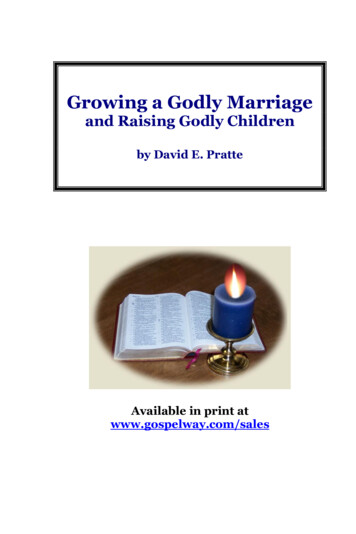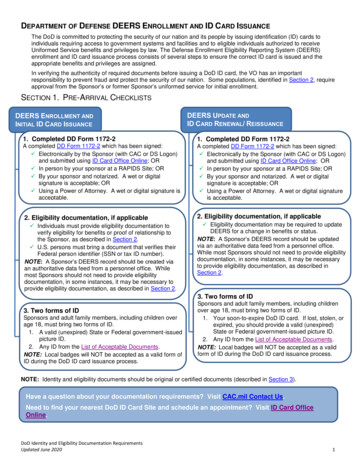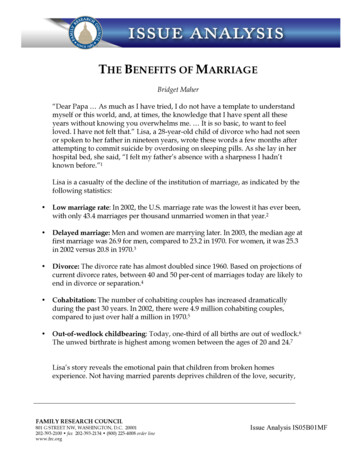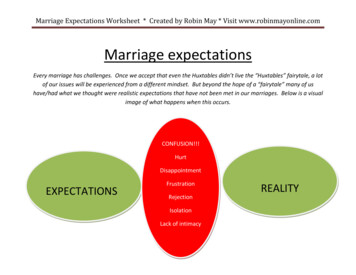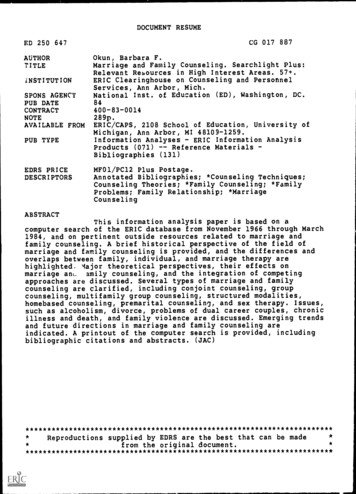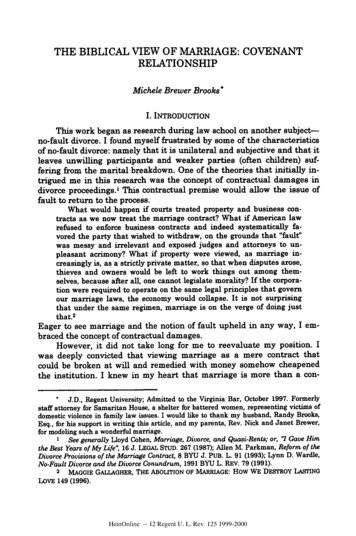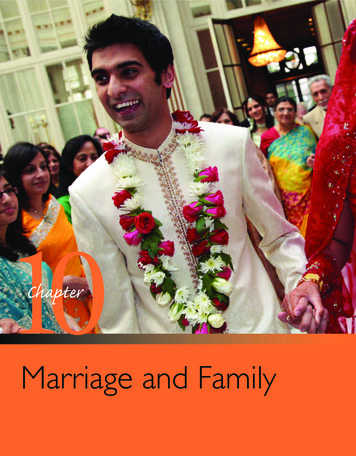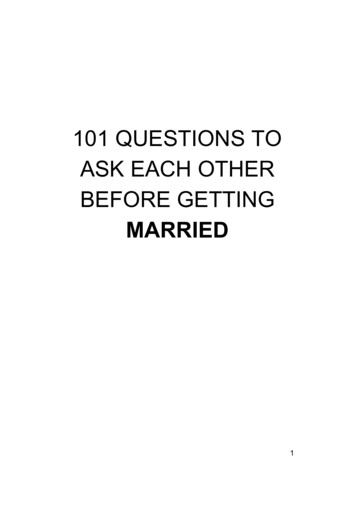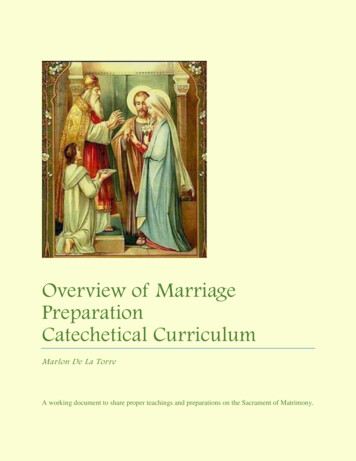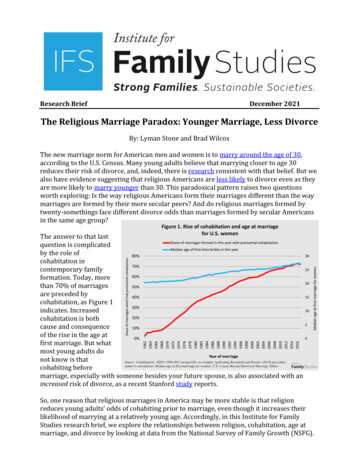
Transcription
Research BriefDecember 2021The Religious Marriage Paradox: Younger Marriage, Less DivorceBy: Lyman Stone and Brad WilcoxThe new marriage norm for American men and women is to marry around the age of 30,according to the U.S. Census. Many young adults believe that marrying closer to age 30reduces their risk of divorce, and, indeed, there is research consistent with that belief. But wealso have evidence suggesting that religious Americans are less likely to divorce even as theyare more likely to marry younger than 30. This paradoxical pattern raises two questionsworth exploring: Is the way religious Americans form their marriages different than the waymarriages are formed by their more secular peers? And do religious marriages formed bytwenty-somethings face different divorce odds than marriages formed by secular Americansin the same age group?The answer to that lastquestion is complicatedby the role ofcohabitation incontemporary familyformation. Today, morethan 70% of marriagesare preceded bycohabitation, as Figure 1indicates. Increasedcohabitation is bothcause and consequenceof the rise in the age atfirst marriage. But whatmost young adults donot know is thatcohabiting beforemarriage, especially with someone besides your future spouse, is also associated with anincreased risk of divorce, as a recent Stanford study reports.So, one reason that religious marriages in America may be more stable is that religionreduces young adults’ odds of cohabiting prior to marriage, even though it increases theirlikelihood of marrying at a relatively young age. Accordingly, in this Institute for FamilyStudies research brief, we explore the relationships between religion, cohabitation, age atmarriage, and divorce by looking at data from the National Survey of Family Growth (NSFG).
2Researching Religion and FamilyTo address the questions addressed in this research brief, we merge data from the NationalSurvey of Family Growth from 1995 to 2019, using responses from over 53,000 women ages15 to 49 to recreate their individual-level family histories. (We focus on women because menwere not included in the NSFG until recently.)1The NSFG included two important questions about religion: first, the respondent’s currentreligious affiliation, and second, what religion they were raised in. Current religious affiliationis not a very informative variable for understanding how religion influences family lifebecause, for example, marriage might motivate people to become more religious (orcohabitation might motivate people to become less religious). But religious upbringing(measured by a woman’s reported religious denomination “in which she was raised” aroundage 14) occurs before the vast majority of marriages or cohabitations, so is not influenced bythem.Thus, we explore how religious upbringing influences family life. Young adults don’t choosewhat religion they’re raised in, so this is about as close as we can get to what researchers call“exogenous” treatment, meaning something like experimental conditions. But becausereligious upbringing could be correlated with many other variables, we also include someimportant controls: a woman’s educational status in each year of her life (i.e., enrolled in highschool, dropped out, enrolled in college, college graduate, etc.), her race or ethnicity, hermother’s highest educational attainment, and whether she grew up in an “intact” family. Wealso control forsurvey wave anddecade.Does ReligionInfluenceMarriage andCohabitation?In the 1960s,about 5% ofnewlywedscohabited beforemarriage. In the2010s, it wasmore than 70%,an enormousincrease. Figure 221 We pool data in much the same way that Michael Rosenfeld and Katharina Roesler did in the Stanford study mentionedabove, and are appreciative of correspondence with them and their sharing of replication files, which helped us to produce acomparable approach: omf.12530.2 Note (Figure 2): Control variables include binary INTACT18 Yes/No; race/ethnic coded as Non-Hispanic White, NonHispanic Black, and Other; maternal educational attainment coded in four categories; time-varying respondent educationalattainment and enrollment in six categories constructed from NSFG educational history data; time-varying dummy variablesfor decade; and non-time-varying dummy variables for survey wave in which a woman was sampled; time increments are
3shows, after incorporating the effects of control variables, that in a typical year of life, about5% of nonreligious women ages 18-49 who have not yet married or cohabited will begin acohabiting union. That figure is nearer 4% for women with a Christian upbringing, nearer 3%for women with a non-Christian religious upbringing (i.e., Mormons and Jehovah’s Witnessesas well as Jews, Muslims, Hindus, and others), and about 4% for religious women on thewhole. In other words, after controlling for a variety of background factors, women who grewup religious are about 20% less likely to begin a cohabiting union in any given year than theirnon-religious peers. As a result, by age 35, about 65% of women with a non-religiousupbringing had cohabited at least once, versus under 50% of women with a religiousupbringing. Not only does religion reduce the odds that young adults cohabit, it also increasesthe odds that they marry directly, or without cohabiting first.Figure 33 illustrates the links between religion and what we call direct marriages, that is,marriages that did not include premarital cohabitation. The trends depicted below in Figure 3show up in similar form for all marriages, but direct marriages are particularly importantbecause they are a closer proxy for the “traditional” relationship pathways promoted bymany religions.For women with a non-religious upbringing who have not yet married or cohabited, about1% are likely to begin a direct marriage in a given year. For religious people generally, it’s alittle more than1.5%. But forwomen withEvangelicalProtestant orNon-ChristianReligiousupbringings, therate of entranceinto marriage isover 2%: this istwice the rate ofentrance into“direct”marriage. By age35, about 28% ofwomen with anon-religiousupbringing hadentered a directmarriageannual with 5-year categorical codes for simplified reporting, however when single-year-of-age dummies are used resultsare essentially identical.3 Note (Figure 3): Control variables include binary INTACT18 Yes/No; race/ethnic coded as Non-Hispanic White, NonHispanic Black, and Other; maternal educational attainment coded in four categories; time-varying respondent educationalattainment and enrollment in six categories constructed from NSFG educational history data; time-varying dummy variablesfor decade; and non-time-varying dummy variables for survey wave in which a woman was sampled; time increments areannual with 5-year categorical codes for simplified reporting, however when single-year-of-age dummies are used resultsare essentially identical.
4without cohabiting, compared to approximately 43% of women with a religious upbringing.In other words, religiosity is associated with vastly greater likelihood of going directly fromsingleness to a married union, and generally at younger ages.Overall, then, religion greatly influences the nature and age of relationship formation. Youngwomen raised in a religious home cohabit less, but they marry more, and especially earlier: inthis sample tracking marriage patterns over the last 40 years, women with non-religiousupbringings wed around age 25, religious women wed generally around age 24, and womenwith Evangelical Protestant upbringings wed around 23.5.Does Religion Influence Breakup and Divorce?Earlier marriage is a known risk factor for divorce. Premarital cohabitation is too. Sincereligiosity tends to motivate earlier marriage but less cohabitation, the effects on divorce arenot easy to guess. What we really want to know is: conditional on getting married, doreligious people getdivorced less?The answer appears tobe yes. Without controlsfor age at marriage or anindicator for premaritalcohabitation, womenwith a religiousupbringing do haveslightly lowerlikelihoods of divorce.As shown in Figure 4,4the annual divorce rateamong married womenwith a nonreligiousupbringing is around5%. For religiouswomen, it’s around4.5%. The effect is clearest for Catholic and Mainline Protestant women, and less clear forEvangelical Protestant women. Overall, if we control for basic socioeconomic background anda woman’s educational career trajectory, the typical marriage of a woman with a religiousupbringing is about 10% less likely to end in divorce within the first 15 years of marriagethan the typical marriage of a woman with a non-religious upbringing.Adding controls for age at marriage yields about the same results, suggesting that eventhough religious people get married younger, their divorce rates are still a bit lower. But itmay just be that religious people cohabit less, and that is what drives the reduction indivorce. To assess this point, we analyze only marriages with no premarital cohabitation, and4 Note (Figure 4): Control variables include binary INTACT18 Yes/No; race/ethnic coded as Non-Hispanic White, NonHispanic Black, and Other; maternal educational attainment coded in four categories; time-varying respondent educationalattainment and enrollment in six categories constructed from NSFG educational history data; time-varying dummy variablesfor decade; and non-time-varying dummy variables for survey wave in which a woman was sampled; time increments areyear of marriage up to the year 16.
5find no effect of religion: women with a religious upbringing have about the same likelihoodof divorce as other women with the same relationship history and socioeconomic status.Most of the benefit ofreligiosity in terms ofreducing divorce occursbecause religiousmarriages are more likelyto be direct marriages,rather than marriages withpremarital cohabitation. Inother words, one reasonthat women raised in areligious home are lesslikely to divorce is thatthey are less likely tocohabit prior to marrying.But while less cohabitationexplains most of thebenefit, it does not explainall of it. We also estimatedspecific divorce rates bymarital duration formarriages of women withreligious or non-religiousupbringings, split by the age at which they got married. Because this creates very smallsample sizes, differences by religion were not always statistically significant, so results mustbe interpreted with caution.Figure 55 shows the estimated annual divorce probability with all the same control variables,but with estimates produced separately for women with different religious upbringings andmarriage types. Figure 5 makes it possible to answer three specific questions: what is theeffect of premarital cohabitation? What is the effect of age at marriage? And what is the effectof religious upbringing?Premarital CohabitationStarting with premarital cohabitation, women with direct marriages (the darker-coloredbars) tended to have lower divorce rates than women with the same religious backgroundand the same age at marriage, but who married after cohabiting. This was especially true forreligious women who married before age 25. For women marrying after age 30, therelationship seems to flip, though estimates are less reliable because, since we can onlyobserve women until a maximum of age 44 in some survey waves and age 49 in others,women who married past age 30 had fewer years of marriage included in the analysis. But5 Note (Figure 5): Control variables include binary INTACT18 Yes/No; race/ethnic coded as Non-Hispanic White, NonHispanic Black, and Other; maternal educational attainment coded in four categories; time-varying respondent educationalattainment and enrollment in six categories constructed from NSFG educational history data; time-varying dummy variablesfor decade; and non-time-varying dummy variables for survey wave in which a woman was sampled; time increments areyear of marriage up to the year 16.
6particularly for youthful marriages before age 20 or in the early 20s, cohabiting beforemarriage appears to be a major risk factor for divorce.Age at MarriageAge at marriage also matters, but in different ways for different groups. For religious womenwho cohabitated before marriage, age is extremely important. Women raised in a religioushousehold who cohabit have very high divorce risks if they marry before age 20, but thelowest risks of any group of women who marry in their 30s. For women raised in anonreligious home who cohabited before marriage, delaying marriage from the teens into themid-20s may reduce divorce risk, but delaying marriage into the 30s doesn’t appear to lowerthe divorce risk at all, and may even be associated with a higher risk. That is to say, fornonreligious women who cohabitated before marriage, there is something like a Nike-swooshshape to divorce risks. Our results parallel the work of sociologist Nicholas Wolfinger here.For these women, getting married in their late 20s maximizes marital stability.For religious women who had direct marriages, marrying before age 20 does have somerisks, but by age 20-24, age at marriage doesn’t appear to carry as much weight: religiouswomen who marry directly have the same likelihood of divorce if they get married at age 2024 or age 25-29, with a modest increase in their 30s.And finally, the same trend holds for non-religious women in direct marriages: they havesomewhat elevated divorce risks if they marry before age 20, low and stable risks duringtheir 20s, and somewhat higher risks if they marry in their 30s. However, because the samplesize of these non-religious women marrying in their twenties is much smaller, error marginsare extremely wide.These results suggest delaying marriage doesn’t always make it more stable. If marriage isdelayed by cohabiting instead, divorce risks are higher: non-religious women with priorcohabitation who married in their late 20s or 30s have the same or higher divorce rates asnon-religious women who married directly or without cohabiting first, in their early 20s.Postponing marriage by substituting cohabitation may not reduce divorce risks. Moreover,for many groups, despite not observing many latter-marriage years where divorce might haveoccurred, divorce risks among those who marry at age 30 or older rose for many groups. Ourresults suggest there may be a “sweet spot” for marriage in the 20s: early 20s for directmarriers, and late-20s for cohabiters. Postponement beyond that age does little for maritalstability, judging by the NSFG data.ConclusionIt is commonly believed that postponing marriage until the late-20s or early-30s reduces theodds of divorce, because greater maturity results in a wiser choice of a partner, and there’ssome truth to this. However, there’s a significant complexity under the surface: the lifeorientations associated with delayed marriage are often also associated with (and evencausal of) greater acceptance of premarital cohabitation, which is also linked to a higher riskof divorce. The net result of this is that life orientations that motivate earlier marriage, likereligiosity, do not necessarily create the higher likelihoods of divorce usually associated withearly marriage because they discourage cohabitation. Yes, very young marriage still has risks(as does very late marriage), but religious upbringings seem to partly compensate for thoserisks, especially among women marrying in their 20s.
7Our results also suggest that religion fosters relationship stability by pushing young adultsaway from cohabitation, which is highly unstable, and towards marriage, which is much morestable. It’s notable that figure 5 did not show meaningful differences in divorce rates betweenreligious and non-religious women who had the same relationship histories: religion seems toimpact relationships mostly by changing the kind of union a woman enters in youngadulthood, not its durability once formed. Insofar as religion changes the type of union thatwomen begin as young adults, and since dissolution likelihoods vary widely by union type,the effect of religion on women’s experience of union instability can be huge. Figure 66provides a simple illustration of divorce or breakup risk by year, by union type.Women who were raised religious are more likely to have a first union which is a direct firstmarriage, and so their first unions are more likely to experience breakup risks similar to thelight blue bar at left. Non-religious women are much more likely to cohabit as their firstunion, which hasastronomically higherbreakup risks, as shownin the red bar at right.The effect ofcohabitation onmarriage is indeedstatistically significant(premaritalcohabitation increasesdivorce probabilities byabout 15%), but thebiggest effect religionhas on union stabilityisn’t about whathappens once a womanis married, but moreabout her relationshipchoices beforemarriage—the fact that she did get married, rather than start a series of cohabitingrelationships. To the extent that the effects associated with religious upbringing are causal,they show that religiosity could dramatically reduce women’s experience of relationshipinstability in early adulthood.What remains unclear is how religion may foster more stable marriages. There are threebroad possibilities: religion might induce people to “make lemons out of lemonade,” it mightgive people institutional or community support, or it might positively alter the quality ofromantic pairings.6 Note (Figure 6): Control variables include binary INTACT18 Yes/No; race/ethnic coded as Non-Hispanic White, NonHispanic Black, and Other; maternal educational attainment coded in four categories; time-varying respondent educationalattainment and enrollment in six categories constructed from NSFG educational history data; time-varying dummy variablesfor decade; age at union formation in five categories; and non-time-varying dummy variables for survey wave in which awoman was sampled; time increments are year of union up to the year 16.
8The first explanation is simple, if pessimistic. If religion induces women who would haveentered a cohabiting union to get married instead, maybe those marriages aren’t betterquality than the cohabiting union would have been, but because of their religious views, thesewomen choose to not divorce.The second possibility is that religion actually changes the experience of being married.Religious communities might provide institutional support to married couples: other marriedcouple friends to provide peers and support, community or pastoral interventions to correctspousal behavior, material or financial support in times of hardship, etc.And finally, religion may change exactly who women marry in important ways. First, religioncould alter the potential spouses to which women are exposed. Via church communities,religious women may be able to access a larger and more marriage-friendly pool of potentialspouses. Second, religion could alter the criteria that women have for selecting partners.Knowing that cohabitation is disfavored and desiring the companionship of a committedunion, religious women might more actively pursue “husband material” partners earlier inlife than other women. Third, religion might alter the dynamics between partners inimportant ways. Religious women might look for spouses who share values, beliefs, orpractices that are important for union stability. Sharing these values might reduce thepotential for conflict down the road.Exactly which of these factors is at work is difficult to say. But one way or another, thisInstitute for Family Studies research brief suggests that waiting to marry until you’re 30 doesnot always increase your odds of forging a stable marriage. Especially for religious men andwomen who avoid cohabitation, our analysis of the NSFG indicates that they can marry intheir 20s without serious adverse divorce risks. The upshot of all this is that the religiousmodel of marriage and family appears to boost the odds that young adults can marry before30 without increasing their risk of landing in divorce court.Lyman Stone is a Research Fellow at the Institute for Family Studies, Chief Information Officer ofthe population research firm Demographic Intelligence, and an Adjunct Fellow at the AmericanEnterprise Institute. Brad Wilcox is Director of the National Marriage Project at the Universityof Virginia and a Senior Fellow of the Institute for Family Studies. Copyright 2021 Institute for Family Studies.
upbringing is about 10% less likely to end in divorce within the first 15 years of marriage than the typical marriage of a woman with a non-religious upbringing. Adding controls for age at marriage yields about the same results, suggesting that even though religious people get married younger, their
